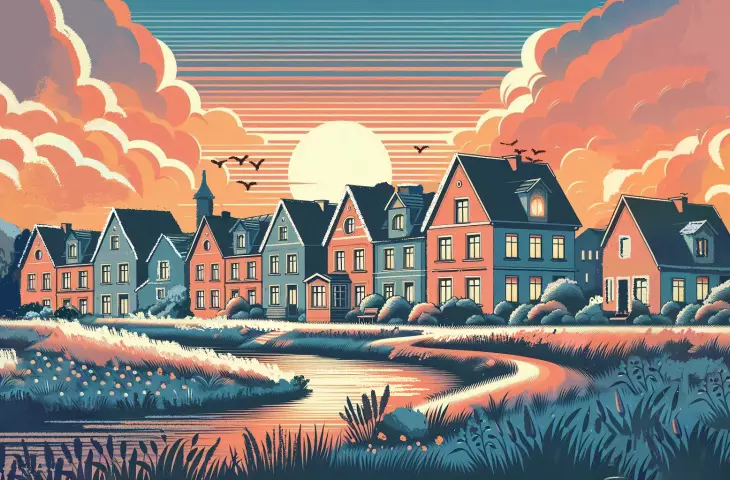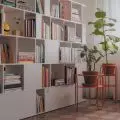We stop noticing the erasure of the suburban landscape, which increasingly brings urban practices into a space with a completely different character. The process probably won't stop, but can we at least talk about it?
rosemary lemonade under a thatched roof
Let's imagine a situation like this - you're on a bicycle tour near the city and want to have some good lunch. You fire up the map and look for it - it turns out that there's basically no problem, there's a diner right next door, you check the rating, reviews - everything checks out. You go in, order, the food is delicious. You pay, you leave. You don't even notice that the prices are actually not very much like under the city, more like in its center.
Along with escaping to the suburbs, often in search of cheaper square footage, however, we want to move our urban habits, such as food. Gentrification of rural, suburban areas in Poland is a phenomenon gaining importance in the context of urbanization processes. The transformation of traditional communities into more affluent and modern centers is increasingly observed. This process is associated with rising real estate prices, changes in the social structure and the gradual disappearance of traditional lifestyles in the countryside.
peaceful countryside
One of the main drivers of rural gentrification is the migration of urban residents to suburban areas. It may be hard for us to imagine it now, but until recently, there was no doe development under the city and no more neighborhoods of sunshine, greenery or oases of tranquility. A house under the city is a relatively new thing, looking from a historical angle. Those who are moving out are looking for cheaper and quieter places to live, away from the hustle and bustle of the city. Rising housing prices and the crowding, traffic jams and noise in cities make rural areas a dream, attractive alternative. Developers are eager to invest in the development of housing in these areas, building new homes, which attracts new residents.
Among the effects of gentrification, the economic ones come to the fore. Rising property values and cost of living are among the most visible effects. Along with this, traditional elements customarily associated with an idyllic view of the rural landscape, such as farmland and pastures, are giving way to new developments. Of course, the demise of small-scale agriculture also has its causes in economic efficiency and the trend toward larger agricultural enterprises, but combined with the proliferation of suburbanization, it is leading to a significant change in the character of the space. The only thing they have in common is the shape of the parcels - terraced houses are being built in swank developments, on de-landed, narrow but long plots of land. The price of plots is rising, finally starting to become a suburb. It is becoming more and more profitable to sell a plot to a developer than to keep the house and orchard. Slowly, hectare by hectare, the space is changing, local residents are being pushed out.
Socially a lot is changing
The phenomenon of gentrification is also leading to significant changes in the social structure of the village. New residents, usually better educated and wealthier, introduce new values and norms. Often the new behaviors clash with the existing culture and traditions of the local communities. Ba, sometimes the new residents want to change the place to which they are brought. So the removal of the septic tank, the mowing of the meadow and, where a field has survived , the harvest begins to disturb. Differences in the way new and old residents function can lead to tensions, lack of understanding and calls to the police.
Culture is also being obliterated in all this. Too intensive transformation of space does not give a chance to stop and at least library-scientific description of the character of locality. The process of gentrification can lead to a loss of traditional values - understood as attitudes and lifestyles, characteristic of the area. Many traditions are somehow transparent, culture can be evidenced by details, but which have shaped the identity of a community for centuries. The influx of new residents and the associated changes in space can obliterate the unique character of these places, which in the long run leads to cultural homogenization.
some things we can't change
Gentrification of suburbs seems to be an inevitable part of modern times. The countryside around big cities is ceasing to exist, even though many of us still remember it. Of course, on the one hand, this phenomenon contributes to infrastructure development and economic growth in rural areas. On the other hand, however, it is leading to the displacement of local communities and the loss of locality. It's hard to talk about any systemic solution here, beyond the standard and now-washed-out attention to identity, more sensible urban planning or building accessible housing. How the character of the neighborhood is changing, the fact that incoming residents expect a city under the city - all this we already know. Perhaps now - in addition to writing texts like these, it is worth capturing what we are already losing: the last wooden houses, apple orchards, grandmother's gardens (which are not lawns with thuyas all around). Maybe what we need is a comprehensive album of suburban Poland, still a bit rural, not yet so rammed with buildings.














